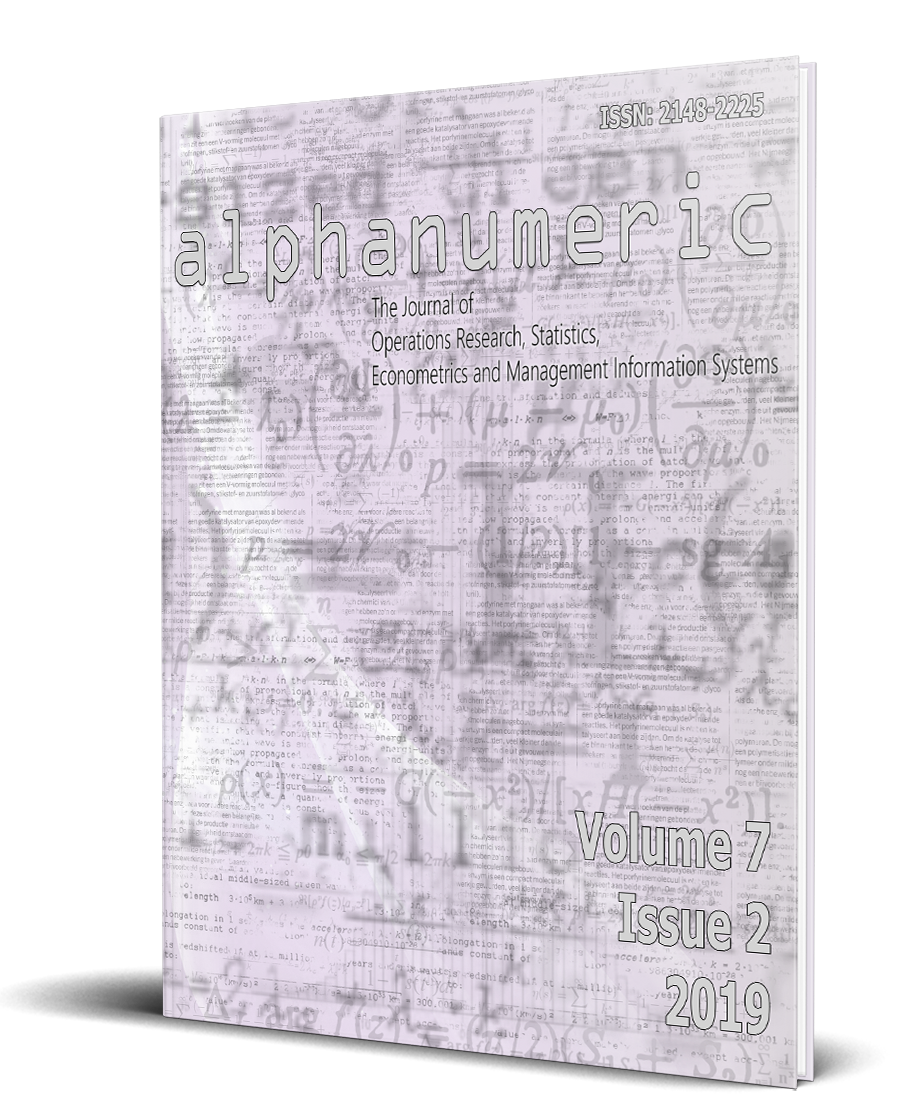
alphanumeric journal
The Journal of Operations Research, Statistics, Econometrics and Management Information Systems
Economic Growth Effects of Economic Integration: An Economic Analysis on Turkish Economy in the Context of the European Union and Shanghai Cooperation Organization
Abstract
For many years the EU countries in Turkey's foreign trade is seen as the main trading partners. However, due to particularly in energy and raw material trade, shares of countries that are members of the Shanghai Cooperation Organization (SCO), especially the Russian Federation and China. also increased in the foreign trade of Turkey. The main purpose of the study is to discuss the comparative view of EU and SCO in the foreign trade of Turkey which goals to be an economic power in its region and reveal the effectiveness of trade with these two trading blocks for Turkey’s economic growth. In the study, data from 6 EU countries and 6 SCO member countries with the highest transaction volume between the years of 2000-2017 were used. Place of 12 countries that considired approximately 42% in the foreign trade of Turkey. The results of the analysis of both trade blocs have been considered to be very important for Turkey's economy. Trading ( import-export) both with EU and SCO countries influence Turkey’s economic growth and variables in both the short and long term shows the presence of a meaningful relationship. Economic growth and foreign trade data show that there is a bi-directional causality between the two trading blocks.
Keywords: European Union, Foreign Trade, Shanghai Cooperation Organization, Turkish Economy
Suggested citation
(). Economic Growth Effects of Economic Integration: An Economic Analysis on Turkish Economy in the Context of the European Union and Shanghai Cooperation Organization. Alphanumeric Journal, 7(2), 185-204. http://dx.doi.org/10.17093/alphanumeric.604525
References
- Azerbaijani, Karim, (2002), “Globalization, Economic Regional Convergence and Effects on Caspian Sea Countries and Caucasian Republics Growth,” Journal of Economic Research, Vol: 61, pp: 149-159.
- Berthelon, Matias, (2004), “Growth Effects of Regional Integration Agreements,” Central Bank of Chile Working Papers, No: 278, pp: 1-40.
- Breitung, J., (2000), “The Local Power of Some Unit Root Test for Panel Data”. In Advances in Econometrics, Volume 15: Nonstationary Panels, Panel Cointegration and Dynamic Panels, ed. B. H. Baltagi, 161-178, Amsterdam: JAI Press.
- Bong, Angkaera & Premaratne, Gamini, (2017), “Regional Integration and Economic Growth in Southeast Asia,” Global Business Review, 19 (6), pp: 1-20
- Im, K. S., Pesaran, M. H. and Shin, Y., (2003), “Testing for Unit Roots in Heterogeneous Panels”, Journal of Econometrics, 115, 53-74.
- Indeo, Fabio, (2016), “The Eurasian Economic Union and the Silk Road Economic Belt: The Impact of the Sino-Russian Geopolitical Strategies in the Eurasia Region,” Maastricht School of Management Working Paper, No: 2016/5, pp: 1-18.
- Haveman, D. Jon, Lei, Vivian & Netz, S. Janet, (1998), “International Integration and Growth: A Survey and Empirical Investigation,” Purdue CIBER Working Papers, 98-003, pp: 1-33.
- Hepaktan, C.Erdem and Serkan Çınar, (2011), “Küreselleşmenin Ekonomik Entegrasyon Üzerine Etkileri,” International Conference on Euroasian Economies,” Bishkek, ss: 68-77.
- Levin, A., Lin, C. F and Chu, C. S. J., (2002), “Unit Root Tests in Panel Data: Asymptotic and Finite-Sample Properties”, Journal of Econometrics, 108: 1-24.
- Marvis, O.Ogedengbe, (2015), “Consolidating Regional Integration in Africa: Lessons from the EU and Shanghai Cooperation Organization,” International Journal of Multidisciplinary Research and Modern Education, Vol: 1, Issue: 2, pp: 143-151.
- Naveh, M. Hosseiny, Torosyan, Toros & Jalaee, S. Abdolmajid, (2012), “Regional Economic Integration and Its Effects on Economic Growth and Economic Welfare,” World Applied Sciences Journal, 17(10), pp: 1349-1355.
- Öniş, Ziya ve Mustafa Kutlay, (2012), “Ekonomik Bütünleşme/Siyasi Parçalanmışlık Paradoksu: Avro Krizi ve Avrupa Birliği’nin Geleceği,” Uluslararası İlişkiler, C: 9, S: 33, ss: 3-22.
- Pedroni, P. (1999), “Critical Values for Cointegration Tests in Heterogeneous Panels with Multiple Regressors”, Oxford Bulletin of Economics of Statistics, 61, 653-670.
- Pedroni, P. (2004), “Panel Cointegration: Asymptotic and Finite Sample Properties of Pooled Time Series Tests with Application to the PPP Hypothesis”, Econometric Theory, 20 (3), 597-625.
- Sarı, Aydın, (2005), “Bölgelerarası Ekonomik Entegrasyonlar ve Türkiye’nin Ödemeler Bilançosuna Etkileri,” Süleyman Demirel Üniversitesi İİBF Dergisi, C: 10, S: 1, ss: 117-130.
- Shao, Yuqun, (2008), “The EU’s Central Asia Policy and Its Implications for China,” Bonn DIE, (Discussion Paper / Deutsches Institut für Entwicklungspolitik ; 9/2008) ISBN 978-3-88985-399-8.
- Şanlı, Bahar, (2008), “Ekonomik Entegrasyon Teorisi Çerçevesinde Avrasya Birliğinin Olabilirliği,” Atatürk Üniversitesi İİBF Dergisi, C: 22, S: 1, ss: 13-30.
- Tatoğlu, Ferda Y, (2012), Panel Veri Ekonometrisi, Beta Yayınları, İstanbul.
- Tatoğlu, Ferda Y, (2012), İleri Panel Veri Analizi, Beta Yayınları, İstanbul.
- TÜİK 2019, Türkiye İstatistik Kurumu, Dış Ticaret İstatistikleri, https://biruni.tuik.gov.tr/disticaretapp/menu.zul, (Erişim: 03.02.2019).
- Velde, D. Willem, (2008), “Regional Integration, Growth and Convergence, Analytical Techniques and Preliminary Results,” Journal of Economic Integration, 26(1), pp: 1-28.
- Zeyrek, Can, (2010), “Orta Asya’da Etkin Bölgesel Bütünleşme Çabaları: Shanghai İşbirliği Örgütü ŞİÖ),” Ege Akademik Bakış, 10 (3), 2010, 871-884.
2019.07.02.ECON.03
alphanumeric journal
Pages 185-204
Received: Feb. 9, 2019
Accepted: Dec. 30, 2019
Published: Dec. 31, 2019
2019 Çam Karakaş, Ü., Karakaş, A., Topal, S.
This is an Open Access article, licensed under Creative Commons Attribution-NonCommercial 4.0 International License.

scan QR code to access this article from your mobile device
Contact Us
Faculty of Transportation and Logistics, Istanbul University
Beyazit
Campus 34452 Fatih/Istanbul/Türkiye
Bahadır Fatih Yıldırım, Ph.D.
editor@alphanumericjournal.com
+ 90
(212) 440 00 00 - 13219
alphanumeric journal
alphanumeric journal has been publishing as "International Peer-Reviewed Journal" every six months since 2013. alphanumeric serves as a vehicle for researchers and practitioners in the field of quantitative methods, and is enabling a process of sharing in all fields related to the operations research, statistics, econometrics and management informations systems in order to enhance the quality on a globe scale.

